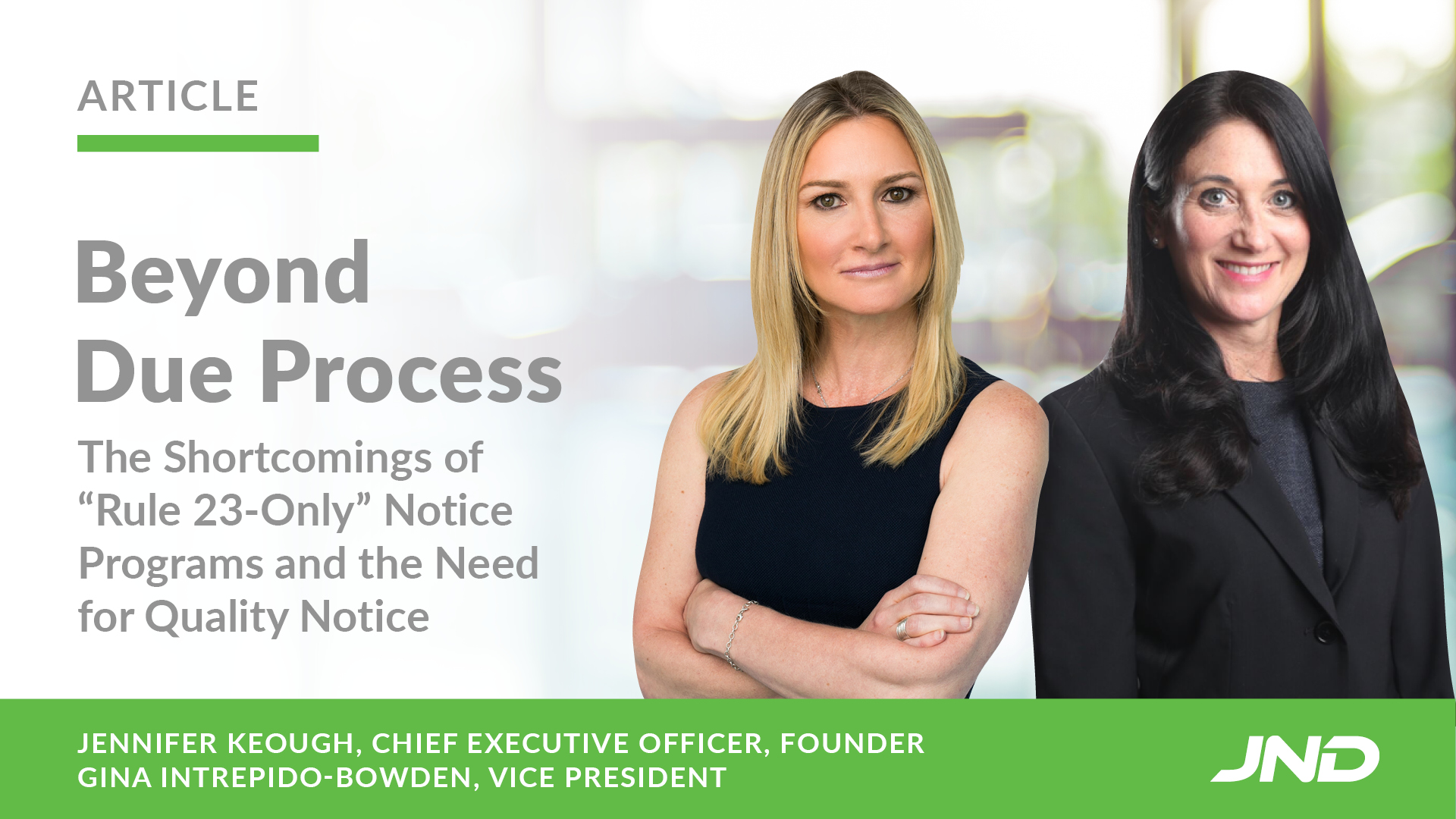Blog
Beyond Due Process: The Shortcomings of “Rule 23-Only” Notice Programs and the Need for Quality Notice
5/6/2025 12:00:00 AM

Jennifer Keough: CEO and Co-Founder, Legal Notice Expert, JND Legal Administration
Gina Intrepido-Bowden: Vice President, Legal Notice Expert, JND Legal Administration
Class action notice programs are intended to satisfy Rule 23 due process requirements and ensure that class members receive reasonable notice of settlements. Unfortunately, many notice programs seem designed just to satisfy the legal threshold for due process without considering whether the notice is truly effective in driving claims. While meeting due process is necessary, it does not ensure that class members engage meaningfully in the settlement process.
The Limits of Due Process as a Benchmark
Due process in class action notification is traditionally interpreted as a requirement to provide notice that is “reasonably calculated” to inform absent class members. Courts rely on the Judges’ Class Action Notice and Claims Process Checklist published by the Federal Judicial Center. The checklist establishes that a notice program reaching at least 70% of the class is generally considered adequate, where reach measures the percentage of unique individuals exposed to a notice at least once.
However, a notice program that achieves sufficient reach under due process standards does not necessarily result in high claim filing rates. A class member who sees a notice once does not necessarily understand it, remember it, or feel compelled to act on it. This approach runs the risk of treating notice as a legal formality rather than a strategy to drive real engagement and participation.
The Failure of One-Time Exposure
A key limitation of due process-based notice programs is their reliance on one-time exposure to achieve the minimum reach required by Rule 23. Research on advertising and consumer behavior consistently shows that an individual requires multiple exposures—typically three to five—before taking action. Class action settlements operate similarly: class members are often suspicious of legal notices and need repeated exposure and clear messaging before they are likely to file a claim. Programs that focus solely on reach, without considering frequency and engagement, risk falling short in delivering actual benefits to class members. Unfortunately, some notice experts design programs in a vacuum—focused solely on meeting legal notice requirements—without considering how the notice strategy integrates with the broader plan for settlement administration. A notice plan that fails to align with the claims process can leave class members confused, disengaged, or unaware of how to take action, ultimately undercutting the very purpose of the settlement.
Driving Claims Through Quality Notice
A more effective notice program goes beyond meeting the minimum due process standard and prioritizes strategies that drive claim submissions. These strategies include:
- Direct Reminder Notices: Sending reminder postcards or emails to known class members who have not yet filed a claim significantly boosts participation. These notices serve as critical prompts for action, particularly when sent close to the claims deadline.
- AI Creative Testing: By leveraging AI audience testing, notice administrators can test digital ads on virtual AI class members before launching full-scale campaigns. This approach allows the notice experts to optimize messaging, visuals, and targeting strategies, which helps ensure that the final notice is as effective as possible in driving engagement and claims submissions.
- Digital Targeting Efforts: Digital retargeting allows notices to reach class members who have shown interest but have not yet filed a claim and look-alike modeling allows notices to reach individuals who are “similar” to those who have already acted. Unlike standard reach-based digital campaigns, these approaches focus on individuals most likely to act.
- Data-Driven Iterative Optimization: Using tracking codes on digital notices allows for real-time adjustments based on which ads and platforms generate the most claims. Refining campaign strategies throughout the process increases efficiency and effectiveness.
Balancing Costs and Impact
Of course, efforts to improve claims participation must be balanced against costs. Notice programs are often paid for by the settlement fund, meaning every dollar spent on notice is one less dollar available for distribution. Still, maximizing reach without considering effectiveness is an inefficient use of resources. Instead, notice programs should strike a balance between ensuring broad exposure and implementing targeted strategies that lead to meaningful engagement and claim filings.
For example, direct mail may be the most effective way to reach known class members, but it comes with high costs. Notice plans can be more cost-effective by supplementing direct mail with email reminders and targeted digital efforts, which can reinforce the message without significantly increasing cost. Similarly, leveraging AI audience testing can ensure that campaigns use only the most effective digital ads and avoid wasting money on ineffective messaging.
Another cost-conscious approach is implementing notice efforts in phases based on response rates. If a broad initial campaign yields strong engagement, additional resources can be targeted to unresponsive class members rather than applying equal spending across the board. In addition, administrators can optimize media placements by continuously monitoring which platforms generate the highest claim conversions and shifting money toward high-performing channels, maximizing impact within a fixed budget.
Conclusion
Meeting Rule 23 due process requirements should be the baseline—not the end goal—of class action notice programs. A notice program that merely checks the legal boxes but fails to drive claims does a disservice to class members. Courts and claims administrators should shift their focus from measuring reach percentages alone to using a more holistic approach that prioritizes actual participation. By leveraging reminder notices, targeted digital efforts, and conversion-based strategies, class action settlements can be more than just legally compliant; they can be truly effective in delivering justice to class members.
Request a Proposal
If you are interested in any of our services, you can request a proposal by filling out the fields in this section.
CONTACT US
- Case Inquiry
- Media Contact
- 1-800-207-7160
- info@JNDLA.com
- www.JNDLA.com
- Careers@JNDLA.com
JOIN US